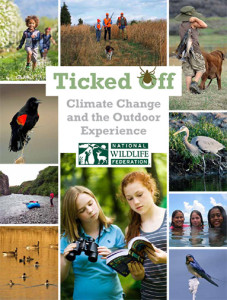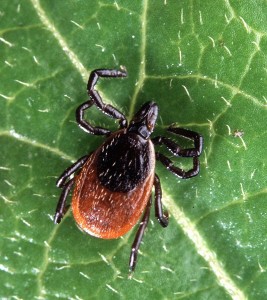We have much more to do and your continued support is needed now more than ever.
Hunters Should Be Ticked Off
 The National Wildlife Federation recently released the report Ticked Off: America’s Outdoor Experience and Climate Change that examines how a warming world negatively affects outdoor recreation by increasing the pests that put a damper on and add danger to outdoor experiences.
The National Wildlife Federation recently released the report Ticked Off: America’s Outdoor Experience and Climate Change that examines how a warming world negatively affects outdoor recreation by increasing the pests that put a damper on and add danger to outdoor experiences.
The report looks at the increasing population size and distribution of nuisance bugs and plants like the tiger mosquito, fire ant, poison ivy, algae, and jelly fish. As the title suggests, ticks and the diseases they carry are featured prominently.
For hunters and other people who spend lots of time in the woods, the threat of Lyme disease and other tick-borne illness can be all-too real. While 95 percent of all Lyme disease cases have come from only 13 states in the Northeast and Upper Midwest, ticks are carriers of many different diseases in many different states that include Rocky Mountain spotted fever in the Mountain West, Heartland virus in the south Midwest, and Ehrlichiosis in the South, among others. Even if they are not disease-carrying, tick bites can itch and irritate for weeks.
Hunting is in the crosshairs
Ticks are just one of the many reasons hunters should be ticked off. There are numerous efforts underway to sell public land which would limit hunting access, place other values of forests before that of recreation, curtail protections to vital watery habitat, and the Senate couldn’t even pass the Bipartisan Sportsmen’s Act earlier this summer because of partisan politics that had nothing to do with our sporting traditions.
Hunters have many reasons to be ticked off, but perhaps the biggest reason to get mad and get involved is climate change’s negative consequences to fish and game habitat.
“Many sportsmen and women are already seeing the effects of climate change on their hunting and fishing opportunities, and are very concerned about what that means to the future of our sports,” said John Gale, National Wildlife Federation’s sportsmen campaigns manager. “Climate change poses an immediate and specific threat to hunting and fishing in America, challenging the traditions and values of sportsmen and women, our respect for the land, and the legacy we leave to future generations.”
Ticks and climate change have recently become a major problem for one of America’s most iconic big game animals, moose, which are revered by hunters and wildlife viewers alike. Moose are in serious decline from New Hampshire and Maine, to Minnesota and Michigan, and even into Montana and Wyoming as tick infestation, overheating and disease tied to warming temperatures leaves them weak and ill. Hunters, while not directly the cause of the decline, are the most affected because many moose seasons are being shortened and harvest tags reduced.
As the Ticked Off report points out, modeling indicates that Lyme-disease ticks will continue to move to higher latitudes and elevations over coming decades, a result of milder winters creating longer tick growing seasons.
Ken Barrett, former host of the sportsmen’s TV show “Life in the Open,” has hunted and fished all around the world and is very concerned about ticks, Lyme disease, and what that means for the future.
“As a boy growing up in the Hudson River Valley, there were few kids who were in the woods more than I was, and I don’t remember ever once finding a tick as a child. Then we had this explosion of deer ticks,” Barrett says in the Ticked Off report. “I know many families are now not letting their children go in the woods because of the concern of Lyme disease. If we don’t let children play in the woods and connect with nature, I think we are really going to be in trouble.”
The connections between ticks, deer, rodents, foxes and hunting
The Lyme disease threat is so worrisome in the Northeast, that some New England towns and counties are trying several innovative and controversial methods to control tick populations, including increased deer hunting seasons, deer contraceptives and pesticides.

While the colloquial name is deer tick, rodents play an equally important role in the parasite’s lifecycle, and rodents are the sole cause of the ticks being a Lyme disease carrier.
There is an ongoing scientific and social debate whether or not culling deer populations actually decreases the risk of Lyme disease. Two recent studies come to completely different conclusions. One study concludes increases in Lyme disease are frequently not correlated with deer abundance and instead coincide with range-wide declines of red fox, the main predator of Lyme-carrying rodents. While another study concludes culling deer populations to levels that reduce the potential for ticks to successfully breed should be an important component of any long-term strategy to reduce the rise of Lyme disease. The report goes on to note, “Additionally, good hunter access to deer habitat and a wide variety of (hunting) management tools (bait, unlimited tags, and incentive programs) are important components of a successful deer reduction strategy.”
For folks in the West who are seeing deer populations dramatically decline — as outlined in another new NWF report, “Legacy in the Crosshairs: ‘Colorado’s Mule-Deer Factory’ on the Decline” — the thought of culling deer herds may seem abhorred. However, some Eastern states have overpopulations of deer that are creating problems for forest ecology, among other concerns.

More importantly, what’s really disconcerting and troublesome is that many hunters are ticked off about the wrong things. Recent polls show that access and conservation are just as important to sportsmen as gun rights, but several organizations would rather overly focus on gun rights, predator control, or high fence trophy hunts, effectively diverting attention away from important habitat issues.
“If you hunt and you are not ticked off, you should be,” concluded Gale. “We need to direct our collective outrage to the problems actually hurting our sporting traditions like habitat loss and fragmentation and misguided proposals to dispose of our public lands, the birthright of all Americans. We can’t play into the hands of those who would limit opportunity by reducing access and hurting efforts to conserve fish and game habitat. We are obligated to future generations to take a stand by advocating for clean water, access and opportunity on public lands, and addressing threats like climate change that are already impacting fish and wildlife habitat.”





















